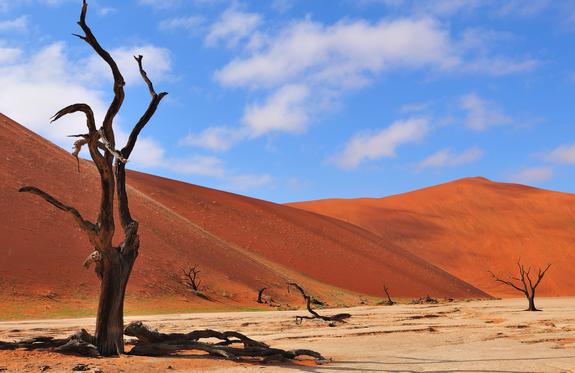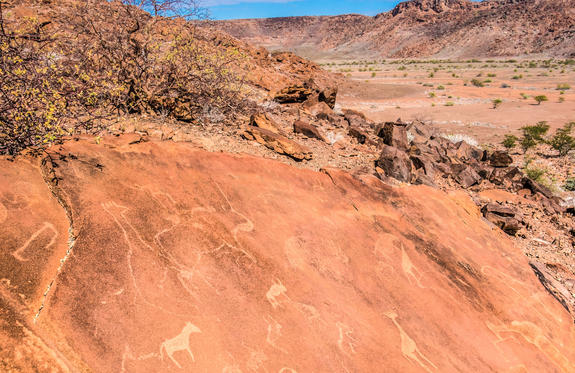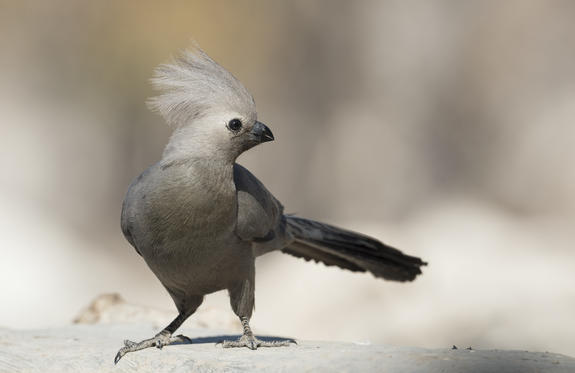Located in southwestern Africa, Namibia boasts a well-developed infrastructure, some of the best tourist facilities in Africa, and an impressive list of breathtaking natural wonders. Visitors can explore the capital of Windhoek and discover the lovely coastal town of Swakopmund boasting remnants of the country’s German influence, reflected in the architecture, culture, cuisine and the annual Oktoberfest celebrations. To properly appreciate this extraordinary country, you will have to venture out of the cities to explore the remarkable natural landscapes Namibia has to offer. These include: the impressive Fish River Canyon; the vast Etosha National Park teeming with abundant wildlife, such as lions, desert-adapted elephants and the Hartmann's Mountain Zebra; the hauntingly beautiful Kalahari Desert; and of course the Namib Desert stretching for over 2000 km along the magnificent Atlantic Coast. Namibia is an ideal destination for travellers seeking an unforgettable African experience in a uniquely beautiful untamed wilderness.

Sossusvlei in the Namib Desert rivals a visit to Etosha as the highlight of a Namibian safari. Surrounded by its distinctive dunes of red-orange sand, Sossusvlei is especially breath-taking in the early morning, when the dunes are transformed into explosions of colour by the first rays of the sun.
Typically you rise with the sun to see this exhilarating sight - some of the largest dunes in the world, rising more than 1000 feet above the desert. This is paradise for the photographer, as the shadows create a magnificent contrast of colours. Marvel at the gemsbok and other animals that manage to survive in these dry conditions. The energetic can climb one of the dunes such as Dune 45 or Big Daddy, for a panorama of the endless dune landscape and the changing play of light. Afterwards you may like to visit Sesriem Canyon. Unless you have your own 4x4 vehicle, you’ll need to join an organized excursion from your Sossusvlei lodge as the final approach is deep sand.

Swakopmund has a distinctive continental atmosphere and many picturesque reminders of the German colonial era, somewhat incongruous in the midst of the Namib Desert! (Founded in 1892 as the main harbour for Namibia, Swakopmund is often described as being more German than Germany.) Now this charming seaside town, with its palm-lined streets, provides a welcome resting place where you can stroll along the beach, enjoy superb seafood or marvel at the High German architecture. The quirky mix of German and Namibian influences, colonial-era buildings and the cool sea breeze contrast with the arid interior.
There's plenty to see in and around Swakopmund such as visiting the Seal Colony at Cape Cross, the flamingos at Walvis Bay and Sandwich Bay. Take a drive to the surreal landscape of the 'Moon Mountains', an area of deep chasms and interesting geological features, or perhaps try some sand-boarding, quad-biking or riding a camel into the desert. There are plenty of day excursions to choose from, even aerial flights over the Namib Desert.

Twyfelfontein is a site of ancient rock engravings in the Kunene Region of north-western Namibia.

Palmwag is a nature reserve idyllically located along a palm-lined tributary of the Uniab River, halfway between Swakopmund and Etosha, providing an ideal base from which to see the sights of the Kunene region or embark on one of the many local hiking trails. Water is scarce in this area, so the river’s presence often lures elephants closer to the camps. The reserve is notable for its unusual species of palm tree, the hyphaene petersiana, and for being home to the largest population of southwestern black rhinos in Africa. Animal lovers can also get a peek at leopard, lion, cheetah, mountain zebra, Angolan giraffe, springbok, kudu, and African bush elephant.

Where Kaokoland meets the Skeleton Coast, in western Namibia, the 270-kilometre-long Hoanib River is one of the last water oases in the country, providing a haven for numerous animals. Home to 75% of Namibia’s endemic species, including the largest numbers of desert-adapted, free-roaming elephants, lions, and rhinos in the world, as well as zebra, kudu, and giraffe, this is a truly exceptional and awe-inspiring place. Visitors can enjoy taking a wonderful four-wheel-drive route, going on adventurous hiking trails, running down enormous sand dunes, or climbing massive, strangely shaped rock formations as well as several guided nature walks.

Sharing the southern boundary with Etosha National Park, the prolific 30 000-hectare private Ongava Game Reserve is considered one of the top private game reserves in the region, enjoying global recognition for exceptional conservation, groundbreaking research and exciting safari experiences. The landscape is characterised by vast open plains dotted with salt plans and abundant wildlife. Visitors can easily access Etosha through Andersson’s Gate in the south.
Known for its luxury lodges made out of natural materials, Ogava is a popular destination for those looking to immerse themselves in nature. The reserve offers visitors the perfect combination of wildlife safari experiences within and around the Etosha National Park. One of Ongava’s top attractions is its rhino population and guests can experience the thrill of getting close to these majestic creatures. Popular activities include: night game drives, guided nature walks, bird watching and 4x4 guided game drives.





